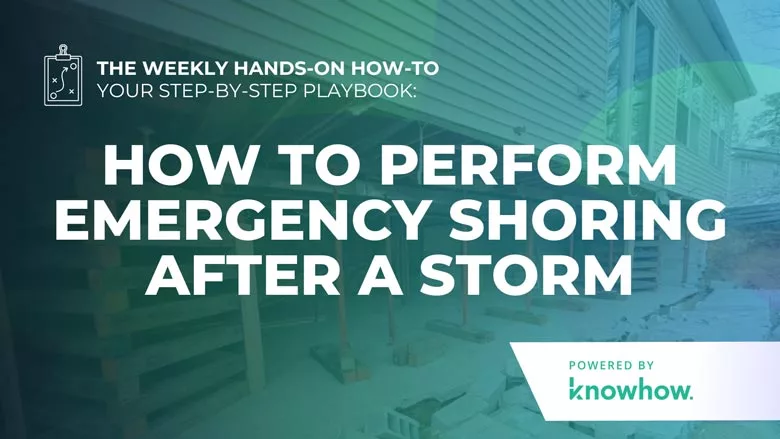Weekly Hands-on How-To powered by KnowHow
How to Perform Emergency Shoring After a Storm
Essential Steps for Restorers to Master Emergency Shoring

All images provided by KnowHow.
When a storm barrels through, it can leave chaos in its wake—damaged homes, unstable structures, and frantic homeowners looking for solutions. As a restorer, stepping into the aftermath means not just mitigating damage but preventing further disaster. That’s where emergency house shoring comes in.
This critical process stabilizes storm-damaged structures, protecting the property, the crew, and anyone who steps foot inside. Shoring isn’t just a safety measure—it’s the foundation of a successful recovery effort, so you’ve got to know how to do it right. So, in this weekly how-to, powered by KnowHow, we’ll teach you exactly how to do it.
From gathering the right materials to positioning supports with precision, you’ll learn how to navigate this high-stakes process with confidence. Here’s how to effectively stabilize a storm-damaged home step by step:
Note: This Weekly Hands-On How-To was based on this template in KnowHow’s template library.
Step 1: Understand the Importance of Shoring
Shoring is a critical process in emergency situations after a storm, as it quickly stabilizes a damaged structure to prevent further collapse or structural failure. Proper shoring protects everyone involved and preserves the integrity of the building. Prioritizing shoring efforts ensures the recovery process can proceed safely and effectively.
Step 2: Gather the Necessary Materials and Tools
Preparation is key to a smooth and safe shoring process. Having the right tools and materials on hand prevents delays and ensures the structure is stabilized correctly. Double-check your supplies to make sure you’re fully equipped for the task. Here’s what you’ll need:
- Wooden or metal beams
- Hydraulic jacks
- Support brackets
- Plywood panels
- Shims
- Screws and nails
- Safety gear (helmets, gloves, etc.)

Step 3: Assess the Extent of the Damage
Before diving into shoring, it’s essential to evaluate the damage thoroughly. This initial assessment lays the groundwork for the entire stabilization process by helping you identify weak points and prioritize your efforts. Look for:
- Cracks in walls or ceilings
- Sagging or leaning walls
- Areas weakened by storm damage
Step 4: Secure the Immediate Surroundings
A cluttered worksite is a dangerous one, especially in emergency situations. Clearing the area ensures a safer environment for everyone involved and allows the work to proceed without unnecessary obstacles. Be sure to:
- Remove debris or hazards.
- Keep pets and children away from the work zone.
Step 5: Inspect all Necessary Shoring Materials
The integrity of the shoring process hinges on using the right materials. From beams to safety gear, each item plays a critical role in stabilizing the structure. Inspect all equipment beforehand to ensure it’s in good condition and ready for use. Gather:
- Wooden or metal beams
- Hydraulic jacks
- Support brackets
- Measuring tools
Step 6: Position Shoring Supports Strategically
The placement of shoring supports is where precision matters most. Proper positioning ensures the damaged structure is adequately stabilized and minimizes the risk of further collapse. Carefully evaluate the damage and place supports as follows:
- Under load-bearing walls, beams, or columns.
- At strategic points to evenly distribute weight.

Step 7: Carefully Lift and Stabilize the Structure
Lifting a damaged structure is no small task—it requires precision, teamwork, and close monitoring to ensure stability. Take your time during this step, as rushing can lead to further damage or injury. Follow these guidelines:
- Use specialized equipment to lift gradually and evenly.
- Continuously monitor the process and adjust supports as needed.
Step 8: Seek Professional Help If Necessary
There’s no shame in calling in the experts when the job requires specialized skills or tools beyond your reach. A professional shoring company can handle severe damage efficiently and safely. Here’s why they’re worth contacting:
- They have access to advanced equipment and techniques.
- Their expertise ensures the job is completed to industry standards.
Step 9: Refer to FEMA Guidelines
For detailed and standardized guidance, consult FEMA's "National US&R Response System 01-00 Structural Collapse Technician" resource. This document offers valuable insights and procedures for safely handling structural damage after a storm.
Step 10: Avoid Common Shoring Mistakes
Shoring is a meticulous process, and even small oversights can have serious consequences. Learning from common errors will help you avoid setbacks and ensure a successful stabilization. Be mindful of:
- Using the wrong materials.
- Failing to position supports correctly.
- Skipping safety protocols.
Building Stability, One Step at a Time
By following these steps, you’ve taken essential actions to stabilize the structure, prevent further damage, and set the stage for recovery. However, restoration projects vary so drastically that even experienced professionals won’t be able to remember every little detail on every job. That’s where KnowHow comes in.
With KnowHow, your team has instant access to detailed company-specific SOPs, real-time guidance, and proven best practices—right at their fingertips, whether on-site or in the office. It’s like having an expert on hand, every step of the way.
Streamline your process and elevate your restoration expertise. Visit tryknowhow.com to see how we can help you build confidence and safety into every project.
Looking for a reprint of this article?
From high-res PDFs to custom plaques, order your copy today!







